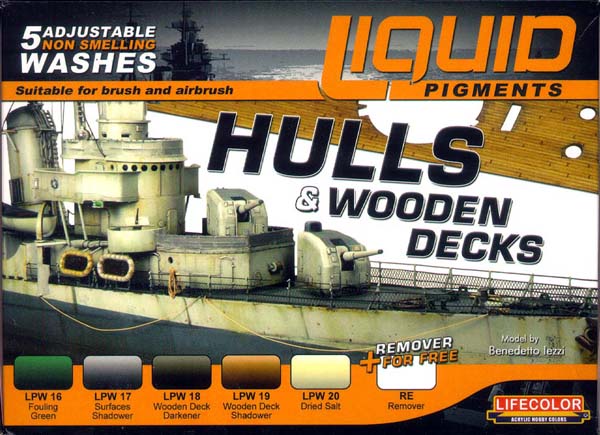| Using Liquid Pigments
Shake well before use. The Liquid Pigments can be mixed together
in order to obtain new colours. The Liquid Pigments can be applied by brush,
airbrush or any method you prefer. Once applied, the Liquid Pigments can
be removed partially or completely from the treated surfaces using a brush
or a cotton bud moistened in the Remover. If just applied, you can remove
the Liquid Pigments with only water. However, the use of the Remover is
always recommended because it is able to completely eliminate the very
dark stains or blots from light surfaces. Preferably use Liquid Pigments
on satin or gloss surfaces. Applying a second coat with a different Liquid
Pigments colour on the same area, the Liquid Pigments will be mixed together.
In order to avoid that, please seal the work with a thin coat of transparent
satin clear (Lifecolor LC77). The locked work will no longer be removable
with Remover.
Using with a brush
Apply Liquid Pigments pure or diluted with water. To highlight panel
lines, lightly moisten the panel lines with water and touch Liquid Pigments
to the corners of the junction; or follow the groove with a fine brush
dipped in the chosen Liquid Pigments. Remove traces leaked from the panel
lines with the Remover. To emphasise bolts or protruding details, moisten
the areas to be treated and apply the chosen Liquid Pigments with a brush.
The excess Liquid Pigments can be removed completely or faded out with
a brush. The Liquid Pigments can be used with the same technique as oil
paints, so they can be stretched or mixed directly on the treated areas
with a dry brush or any other tool. the Liquid Pigments can also be used
as a filter for modulating light or dark areas on a surface.
Using with an airbrush
Apply Liquid Pigments with an airbrush without adding water. Remove
or correct the product with brushes or other instruments moistened with
the Remover. It is also possible to move or accumulate the Liquid Pigments
on a surface by spraying it away with the Remover using the airbrush after
the Liquid Pigments have dried or by blowing only air on the Liquid Pigments
before the Liquid Pigments have dried.
Using with a sponge (chipping)
Moisten the sponge or similar in the Liquid Pigments, discharge the
excess product on paper and apply on the model. |


 This
is one of the many different sets from LifeColor they can be found AirBrushes.com.
Check out their line of paints, wathering products, and of course
an airbrushs.
This
is one of the many different sets from LifeColor they can be found AirBrushes.com.
Check out their line of paints, wathering products, and of course
an airbrushs.
